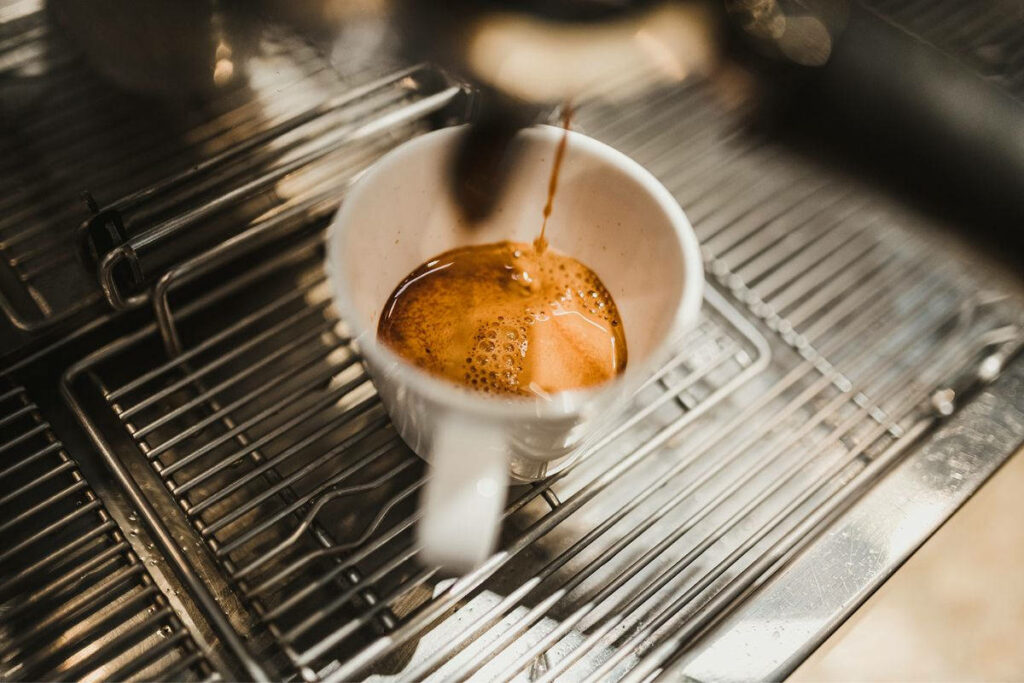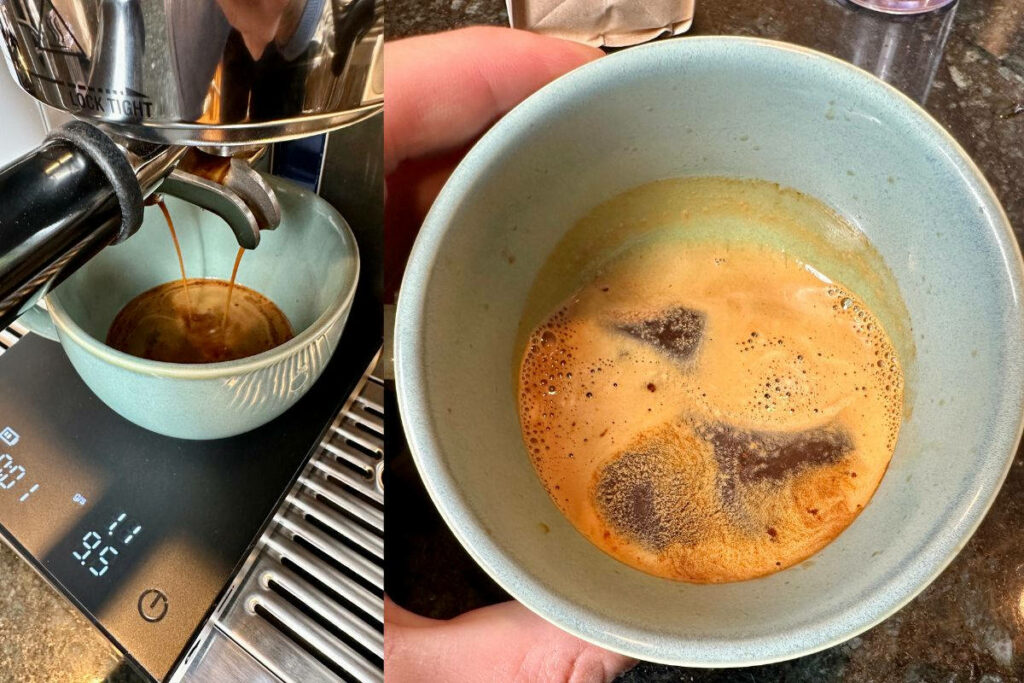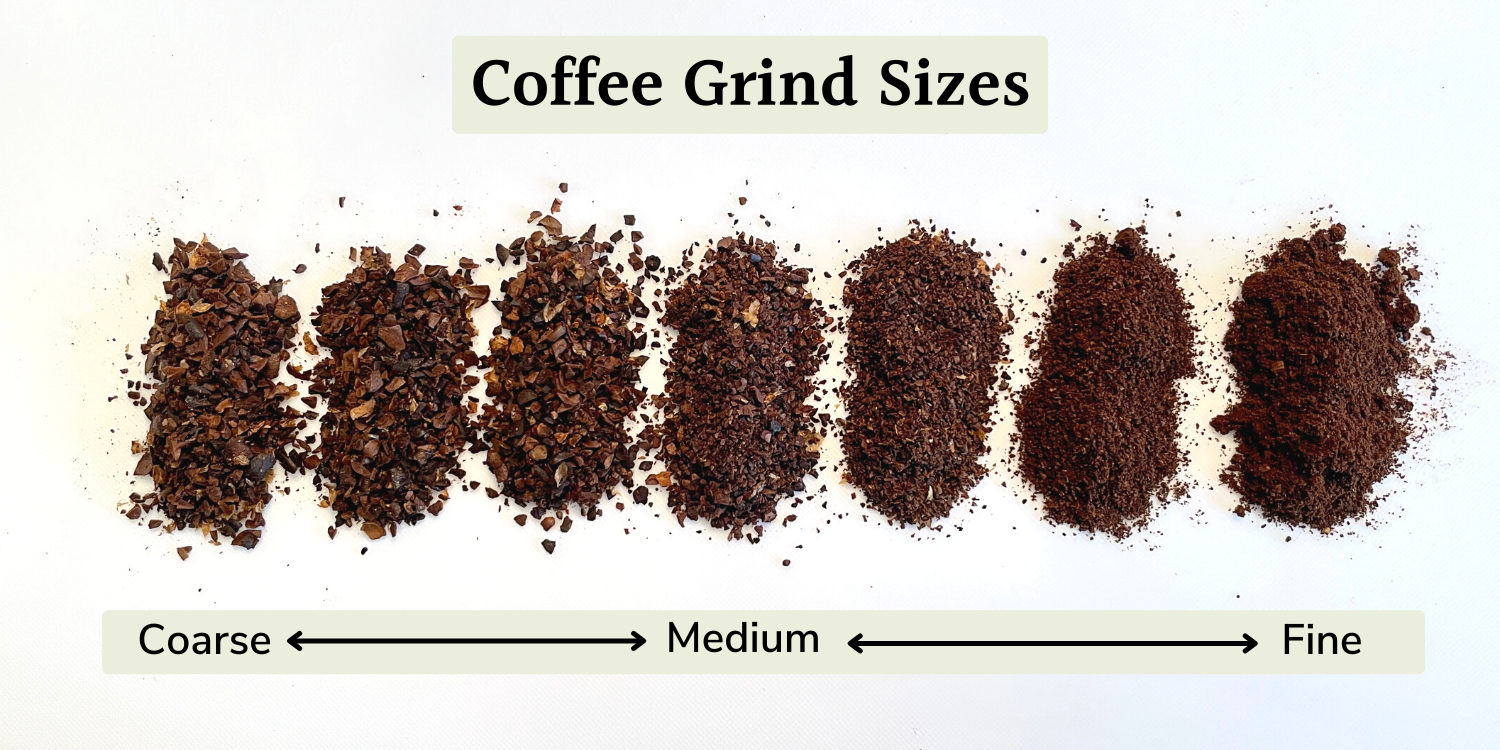A good espresso shot is flavorful, rich, and smooth, with velvety crema on top. But, the opposite happens to the best of us — you pull a shot and have a sour, bitter, or burnt espresso.
Many things can cause an espresso to taste sour and bitter. For example, adding too much water, coffee beans not ground finely enough, over or under-extracting. Luckily, these issues are easily fixed.
Today, I’ll go over all the reasons your espresso can taste sour or bitter, and I’ll give you detailed instructions on how to fix the espresso taste, so you can have a flavorful brew every time.

A Quick Primer On Sour and Bitter Taste
Oftentimes, the coffee industry (and ourselves at Craft Coffee Spot) throw around “sour” and “bitter” loosely without describing what sour and bitter coffee actually tastes like. It’s complicated because all coffee has some blend of sourness and bitterness, and that complexity makes coffee special. Taste is nuanced and hard to define, but let’s set a simplified understanding.
In general, think of sour as acidic – like licking a lemon. Meanwhile, bitter taste comes from alkaloids and is like dark chocolate. Bitterness often comes with astringency, which is a drying taste.
Your coffee is probably too bitter if you need to drink water after. It’s too sour if your lips pucker up and your mouth waters.
A simple way to create a sour and bitter taste is to pull one espresso into two cups. Pour the first 10-15 seconds of the shot into one cup, then swap in a second cup for the remaining 10-20 seconds. The first half will be sour, while the second half bitter. That’s because the lighter, acidic notes are extracted first, while heavier, astringent notes come out later.
Sour Espresso: What Does It Look Like and Quick Fix
Sour espresso gushes out of your espresso machine in 15 seconds or less. The liquid is pale yellow and bubbly. The crema dissipates rapidly, and the puck is dry and powdery.
Sour espresso is an under-extracted shot. This means the water runs through the coffee too fast, and the coffee oils that give the espresso the delicious flavor don’t get extracted.

The most common reason for sour espresso is your grind size is too coarse. Other reasons for a sour espresso are that you use the wrong beans (light coffee beans are sourer in an espresso machine), don’t put enough coffee in the filter basket, or tamp too lightly. All this results in a pour that lasts less than 15 seconds. Separately, the water temperature could be too low, which probably means your machine needs to be descaled.
Here are the best fixes for a sour espresso shot:
- Grind finer. The grounds create better resistance for the water to pass through and extract more oils when you tamp.
- Tamp more firmly. Compress the grounds more when tamping.
- Add more coffee to the basket.
- Increase the water temperature, and preheat the portafilter.
Essentially, all the fixes for sour coffee create more resistance against the water, which makes the water flow more evenly through the puck.
Bitter Espresso: What Does It Look Like and Quick Fix
Bitter espresso has a very dark brown color that’s especially thick. The puck is usually soggy with a pool of water. The pour lasts too long — over 45 seconds.
Bitter espresso means your espresso shot is over-extracted, i.e., the extraction is too long. The hot water flows through the ground coffee slowly, which results in a longer contact time. The coffee tastes burnt and harsh.

If you want to get technical, a bitter espresso taste happens because of the tannic acid in the coffee beans. This acid builds up in the outer exterior of the coffee beans, and the plant uses it as a defense against insects. Because tannic acid is a heavier compound, it needs high temperature and high pressure to be extracted. It usually comes out at the end of the pour. If your espresso shot is longer than 45 seconds, there’s a high risk of this bitter acid leaking out into your espresso shot, which results in a bitter taste.
Bitter espresso also happens because of dirty equipment, wrong grind or wrong coffee beans, too much water and not enough coffee beans, and too hot temperature.
Here are the fixes for a bitter espresso taste:
- Use a coarser grind size. If your roasted coffee beans are ground too finely, it’s difficult for water to flow through the puck, so you need a coarser grind.
- Change the coffee-to-water ratio. Ideally, you should have a 1:2 ratio of coffee to water.
- Reduce the water temperature. Your temperature can be too hot, so you should lower it.
- Try different beans. Dark roast has a bitter flavor profile. Also, old coffee beans can make coffee taste burnt.
- Clean the machine. Coffee residue and oil build up in the espresso machine over time and make the espresso taste bitter. Purge the group head and clean the portafilter.
Different Reasons Why Espresso Tastes Bitter or Sour? (And How To Fix Each One)
Grind Size
- Sour espresso: Grind finer
- Bitter espresso: Grind coarser
Grind size may be the biggest factor that determines your espresso taste. If your grind is too coarse, you’ll have an espresso that pours too quickly because The coffee grounds aren’t exposed to the water long enough to extract their full, rich flavor. The water runs through the large spaces between the ground coffee. The result is a sour taste.
The fix is to grind finer. This exposes more surface area to water and slows the brew, so you don’t end up with an under-extracted brew.

On the other hand, if your grind size is too fine, the water takes too long to pass through the grounds, so you have a bitter espresso taste. You’ll notice because the espresso barely flows. If your extraction time is over 45 seconds, grind coarser.
Tip: Make small changes to the grind, for example, 1 to 2 steps on the Barista Pro or 1 step on the Barista Express. Generally, the grind should be slightly finer than table salt, but keep making changes to the grind until you find the sweet spot for your coffee beans.
Bean Choice
- Sour espresso: Try medium or darker roast instead of light
- Bitter espresso: Try lighter and medium roast instead of dark
Beans can also make the espresso taste sour or bitter. Remember, you should lean towards dark roasts for espresso because espresso uses a higher ratio of coffee and brews quickly, which means it’s inherently less extracted than regular coffee.

Certain single-origin beans tend to have a high acidity level, which makes sour or bitter coffee. On the other hand, coffee blends lose a lot of acidity during processing and roasting. Try a dark roast blend if you used single-origin beans and ended up with sour or bitter coffee.
African and Central American beans are also highly acidic, resulting in a sour-tasting coffee. Also, light roast beans usually produce sour coffee.
On the other hand, dark roasts tend to be bitter. Robusta tends to be more bitter than Arabica because it has higher levels of bitter compounds, so you can try Arabica if your espresso has a bitter taste.
Overall, every bean is different, so find the blend that suits your taste. A good way to start is to go for beans that match your taste preferences. For example, if you like acidity, go for beans with descriptors with fruit names, such as berries, citrus, and more. Or, if you want more bitter-tasting espresso coffee, go for bean descriptors such as cocoa, nuts, and chocolate.
One thing to keep in mind is that fresher doesn’t mean better in the world of coffee beans. If you brew espresso with beans that are too fresh, there’s still carbon dioxide, which hinders extraction and can brew sour coffee.
You should wait at least five days after roasting before brewing espresso. Coffee beans need time to degas (release carbon dioxide that accumulates during the roasting). Dark roasted beans degas faster (closer to five days), and lighter roasted beans degas slower (closer to ten days) before reaching peak flavor.
Coffee-to-Water Ratio
- Sour espresso: Try a higher brew ratio (more water)
- Bitter espresso: Try a lower brew ratio (more coffee)
The brew ratio is the amount of ground coffee in relation to the amount of espresso. The standard espresso shot brew ratio is 1:2, which is 18g of ground coffee. This produces 36 ml of espresso. But different roast levels and coffee beans need different ratios.
You can have a sour taste if you use a smaller dose of coffee. You need a larger dose of coffee, so there’s enough ground coffee in the portafilter to create resistance to hot water and increase the contact time between the grounds and hot water.
Generally, a lighter roast is more difficult to extract compared to a darker roast. You should use a higher brew ratio for a light roast, for example, 1:2.5. This produces between 34 – 42 ml.
Try a lower brew ratio if you use a dark roast and have a bitter espresso. This means less coffee in the portafilter and shorter coffee and water contact time. Try a 1:1.5 ratio, which produces a 27 ml espresso shot.
Water Temperature
- Sour espresso: Try higher water temperature
- Bitter espresso: Try lower water temperature
The ideal coffee brewing temperature is 195 degrees to 205 degrees. The water temperature should be just under the boiling point. If your temperature is too low, you’ll have a sour espresso. This results in under-extraction because cold water can’t do a complete extraction.
Bitter espresso can happen because your water temperature is too hot. This indicates over-extraction, so you should lower the temperature by a few degrees.
Here are some tips on water temperature for the best espresso shot:
- Let the espresso machine warm up. Some machines can warm up in seconds, but some need upwards of 20 minutes to reach the ideal brewing temperature.
- Run a blank shot with the portafilter inserted (but no coffee) to preheat the espresso machine and all the parts. All the internal parts should be at optimal temperature. This means the portafilter, group head, and cups should be heated.
- Try increasing or lowering the temperature by one or two degrees and see if this solves espresso tasting sour or bitter.
- Lighter roasts are more difficult to extract and need a higher temperature. Darker roasts are easier to extract and need a lower brewing temperature.
Puck Preparation
Finally, puck preparation is an important step to avoid sour or bitter taste. Once you choose the right beans for your espresso shot and grind them to the correct level, you need to pack them tightly in the portafilter to avoid channeling.
The key is to get a level puck, not necessarily one that is extremely firmly packed. To do so, you need to distribute the coffee in the puck evenly. We’ve discussed distribution before. I like to tap the bottom of the portafilter to remove air pockets.

Also, don’t overfill the portafilter and break up any clumps. You can brush off excess coffee and use a WDT device to break up coffee clumps.
Finally, you have to tamp the coffee. Tamping seals in the dry grounds against the basket walls. You don’t need to use your whole strength to tamp, but do it until the ground coffee stops compressing, and keep it level.
You want to avoid channeling, which happens when water finds its way into gaps between ground coffee. There’s a visible channel or a path in the puck. Water goes through this channel and avoids the rest of the grounds, so the channel is over-extracted, and the rest of the puck is under-extracted.
Here are all the reasons channeling happens:
- Uneven coffee distribution in the portafilter
- Clumps in the coffee puck
- Bad tamping
- Too little or too much coffee in the portafilter
Tip: Try pre-infusing your espresso shot for an even lower chance of channeling.
What to Do if Your Espresso Tastes Sour or Bitter
The first thing to check is the grind size, which is the most important factor to dial in espresso. Water temperature, coffee-to-water ratio, and bad puck preparation are other culprits that can make your espresso taste sour or bitter. Luckily, there’s a solution for all of these. You should try a darker roast, hotter temperature, and a higher brew ratio if your espresso is sour, or do the opposite if the espresso is bitter.
Also, don’t disregard the cleanliness of your espresso machine. Coffee oils and coffee grounds residue builds up in the machine, which negatively affects the espresso coffee flavor. Check out our guide on how to clean and descale your espresso machine for the most flavorful espresso shot.




